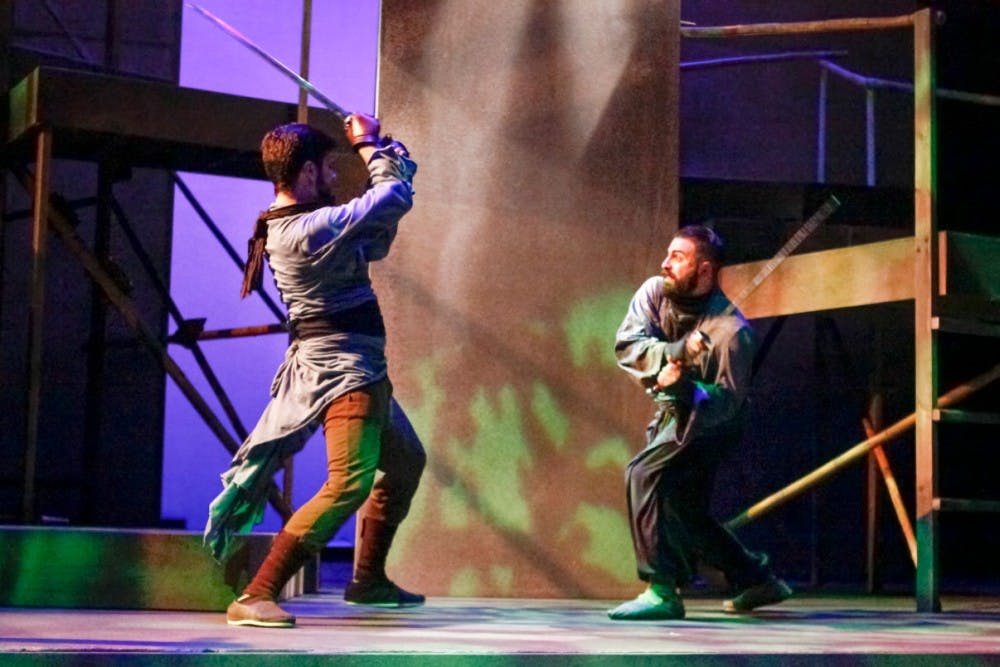The Division of Theater practices diligently to stay safe during main stage productions.
Just before a technical rehearsal for Rashomon begins, the actors take the stage, and Emilio Tirri, who plays Tajomaru, slaps the wigmaker Callie Sour across the face.
Or rather, he pretends to slap her.
The actors are in the middle of a fight call, a brief rehearsal of the fight choreography that takes place before each run-through of the show.
It’s just one of the many protocols productions follow to ensure the maximum amount of safety on and off stage.
Fight calls build muscle memory and warm up the actors for the actual scene in the play, said Brian Evans, associate professor of theater and director of Rashomon.
Evans is also the fight choreographer, a role he has fulfilled since he started at Ohio University eight years ago and something he has done professionally since 1988. Evans is a certified teacher with the Society of American Fight Directors.
With stage combat, everything is timed and practiced to perfection because anything different can possibly cause harm to an actor. An actor speeds up a fight in the heat of the moment or misses the target for a punch: these are the moments Evans strives to avoid.
Distance is key in hand-to-hand fight choreography. Evans said on average there should be a space of six to eight inches. He added sometimes he’s comfortable with someone being four inches away, but with others, he requires one foot. It’s all practiced at different speeds to build muscle memory.
The props necessary for the fight scenes are made specifically for the stage. The swords used in Rashomon are made with tempered steel so they are more flexible and won’t break on stage. They are also blunted, so the dull blade won’t cut into the other, which could create divots in the partner’s sword, otherwise making that sword a serrated knife, Evans said.
“You never want to buy from the late night advertisements on QVC,” Evans said. “They’re very dangerous and will break on stage.”
Theatrical firearms have even more procedures. One person is designated as the supervisor of the weapons and is the only one who can pass them out before a show, load and unload them and keep them in a locked box.
Stage combat is a more visible manifestation of putting safety into practice because it’s seen during the performance. However, behind the scenes, a countless number of other protocols must be followed even if their results go unnoticed by an audience.
The platforms actors walk under need to have a 6-foot clearance. Extra supports might be required for platforms to be more secure. Steps need to have about 8 to 10 inches of space. Most significantly for Rashomon, railings must be added at specific heights, typically three to four feet.
“We have safety regulations and I have to accommodate them in the design,” said Erin Hemming, a third-year graduate student studying scenic design and the scenic designer for the play. “I’ve come to embrace the railings.”
As the technical director of the show, Preston Sullivan said he has to interpret the designer’s artistic idea into something that can be physically built.
Sullivan, a second-year graduate student studying technical direction, said the Division of Theater productions abide by the regulations set by Actors’ Equity, Occupational Safety and Health Administration and the Ohio Health and Safety Board.
Adding another level of safety and precaution is the SHAPe Clinic, or science and health in artistic performance. The clinic began in August 2013 and has been striving to bring awareness to artistic injuries and safety ever since.
One way this is accomplished is when the SHAPe team walks through the performance space to assess any possible safety issues — looking at head clearance, stability and more. The team is also present at every performance and fight call with a mobile clinic in case of any injury.
“Because of our background and understanding of injuries, we have a different kind of eye,” said Jeff Russell, the director of the clinic. “They already know about a lot of potential problems, but we always find something else that needs to be taken care of.”
@buzzlightmeryl
mg986611@ohio.edu






